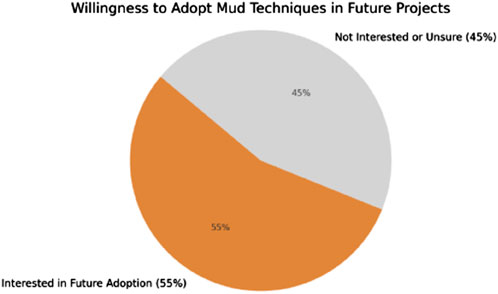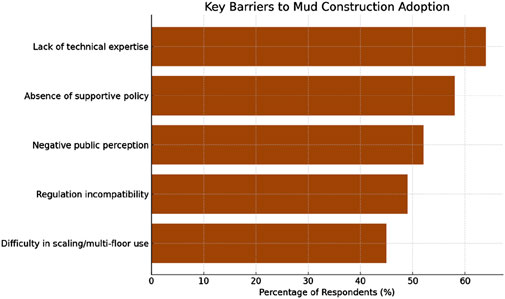- Department of Architecture, Covenant University, Ota, Nigeria
The Nigerian building industry faces a dual challenge of environmental unsustainability and cultural erosion. This study examines contemporary professional engagement with mud techniques among architects practising on Lagos Island, an area symbolic of rapid urbanisation and cultural transition. A quantitative survey method was employed, using questionnaires distributed to architects, with results analysed through descriptive statistics. The findings reveal increasing awareness of mud’s ecological and cultural benefits; however, adoption remains limited due to concerns over durability, lack of technical innovation, and regulatory uncertainty. While many respondents recognised mud’s sustainability potential, outdated perceptions and weak policy frameworks continue to hinder its mainstream application. The study recommends targeted policy interventions, professional capacity building, and curriculum reform to reposition mud architecture as a viable, sustainable option within Nigeria’s construction sector.
1 Introduction
The global construction industry is increasingly scrutinised for its significant environmental impact, with the sector responsible for nearly 40% of energy-related carbon dioxide emissions (United Nations Environment Programme, 2020). In Nigeria, where rapid urbanisation and population growth fuel an ever-expanding built environment, the dominance of concrete and steel continues to escalate ecological degradation and undermine local sustainability objectives. Despite this reality, indigenous construction methods, particularly those involving earthen materials such as mud, offer time-tested, climate-responsive, and culturally rooted alternatives that remain vastly underutilised in formal architectural discourse and practice (Odum and Uwakonye, 2019; Ehkaese and Amole, 2014). In tropical regions such as Nigeria, building performance challenges are further exacerbated by high heat, humidity, and rainfall, requiring design strategies tailored to these climatic realities (Babalola et al., 2024).
Mud construction in Nigeria has been historically recognised for its affordability, thermal comfort, environmental friendliness, and cultural symbolism (Ibrahim et al., 2024; Dabare et al., 2023). However, despite these advantages, applying mud techniques in contemporary public and urban building projects remains minimal. This underutilisation stems from multiple barriers, including negative societal perceptions, limited technical capacity, policy neglect, and a lack of integration within architectural curricula (Jegede et al., 2017; Morel and Charef, 2019; Toriola-Coker et al., 2021). Professional engagement with mud construction is often influenced by intrinsic motivations, such as environmental consciousness, and extrinsic pressures, including client expectations and regulatory frameworks (Davis et al., 1992).
This study, therefore, investigates the contemporary professional engagement with mud construction techniques in Nigeria, with a specific focus on Lagos Island. It explores professionals’ perceptions, levels of readiness, and resistance, as well as the implications for sustainability and cultural continuity within Nigeria’s urban architectural landscape. This paper addresses the implementation gap by examining empirical evidence gathered through structured questionnaires. It provides insight into policy, educational, and training reforms necessary to reposition mud construction as a viable tool in achieving sustainable development goals.
1.1 Problem statement
Despite the increasing global demand for sustainable construction methods, Nigeria continues to overlook the potential of indigenous building materials. Mud, an abundant and renewable resource, remains marginalised in mainstream construction, especially within urban centres. Studies reveal that indigenous architectural heritage is rapidly disappearing due to modernisation, regulatory neglect, and professional disinterest (Onyejegbu et al., 2023; Loew, 2003; Ndukwe, 2022). The disconnection between sustainability ambitions and construction practices is further deepened by professionals’ limited awareness, scepticism about material durability, and inadequate policy support (Vidak-Vasić et al., 2023; Toriola-Coker et al., 2021). Consequently, the architectural profession remains unprepared to harness the benefits of mud construction in climate-resilient and culturally responsive urban design.
1.2 Aim and objectives
1.2.1 Aim
To evaluate the current levels of professional engagement with mud construction techniques in Nigeria and draw policy-relevant insights for sustainable and culturally inclusive architecture.
1.2.2 Objectives
1. To assess contemporary architects’ awareness, readiness, and resistance towards using mud as a construction material.
2. To identify systemic barriers and enablers influencing the adoption of mud techniques in public architecture.
3. To propose policy and educational recommendations that promote the integration of mud construction into sustainable development frameworks.
1.3 Research questions
1. What is the current level of awareness and adoption of mud construction techniques among architects in Lagos Island?
2. What professional and systemic barriers influence the rejection or acceptance of mud in public architecture?
3. How can policy, education, and professional training enhance the future integration of mud construction in sustainable architecture?
1.4 Scope and limitations
The study focuses on professional architects practising on Lagos Island, drawing empirical data from structured questionnaire responses. Geographically, the study is limited to Lagos Island, an urban hub representing a cross-section of contemporary Nigerian design practice. The scope is narrowed to perceptions and institutional factors rather than site-based material performance. Limitations include self-reported data bias, the exclusion of government agencies and clients, and the regional specificity that may not represent national trends.
1.5 Significance of the study
This study provides evidence-based insights into the current attitudes of Nigerian professionals towards indigenous construction, focusing on mud techniques. It contributes to the literature on sustainable architecture by bridging theory and practice within a local context. Practically, it informs policymakers, educators, and urban planners about the gaps and opportunities in integrating vernacular construction methods into mainstream architectural development. The study supports global sustainability goals (SDGS) by advocating for low-carbon, culturally resonant, and socially inclusive building systems.
2 Literature review
2.1 Environmental urgency in the Nigerian building sector
The construction industry globally accounts for about 40% of greenhouse gas emissions, making it one of the most environmentally burdensome sectors (United Nations Environment Programme, 2020). In Nigeria, unsustainable practices prevail, with concrete and steel dominating the construction landscape. Adoption remains low despite the availability of low-carbon, locally sourced materials like mud. Morel and Charef (2019) argue that barriers to using earth-based materials include poor technological integration, weak regulation, and limited professional awareness, which is especially relevant in fast-growing urban centres like Lagos.
Globally, there is renewed urgency to shift to sustainable alternatives as construction accounts for nearly 37% of total energy-related carbon emissions (United Nations Environment Programme, 2020). Mud, being abundant, recyclable, and low in embodied energy, offers a key response to these challenges, especially in contexts like Nigeria, where resource efficiency and affordability are critical (Cuitiño and Esteves, 2018; Giuffrida et al., 2021).
2.2 Cultural and architectural identity
Loew (2003) highlights the conflict between modernisation and cultural preservation in architecture. Indigenous architecture in Nigeria is rapidly diminishing under the pressures of urbanisation and globalisation. Onyejegbu et al. (2023) stress that mud buildings retain cultural and symbolic value, particularly in the southeastern regions. However, architectural education has failed to keep pace. Jegede et al. (2017) and Ibrahim et al. (2024) point out the lack of traditional methods in curricula, which results in a disconnection between modern professionals and vernacular heritage.
Mud construction is also central to the architectural identity of West Africa, where traditional compounds and palaces illustrate how earthen techniques embody cultural continuity. Preserving such practices ensures that modern architecture remains rooted in local heritage rather than entirely shaped by imported materials (Onyejegbu et al., 2023; Nichols, 2023).
The sociological significance of mud construction lies in its role as a communal practice, where knowledge is transmitted intergenerationally and construction fosters social cohesion. These positions may not just be seen as a material choice but as a means of sustaining community identity and collective memory (Onyia, 2023; Jegede et al., 2017; Ibrahim et al., 2024).
2.3 History and theoretical foundations of mud architecture
Historically, mud has been used in some of the world’s most enduring monuments, from the Great Mosque of Djenné in Mali to traditional Hausa earthen compounds in northern Nigeria, demonstrating its durability and cultural importance (Onyejegbu et al., 2023).
The theoretical justification for mud’s continued relevance lies in its alignment with sustainable design principles, especially its thermal performance, biodegradability, and adaptability to local climates (Cuitiño and Esteves, 2018; Giuffrida et al., 2021).
Beyond technical qualities, mud embodies sociological and symbolic functions (Grigar, 2021). In Nigeria, earthen compounds have historically reflected status, lineage, and spirituality, reinforcing their position as a material deeply tied to social meaning (Onyia, 2023).
2.4 Mud as a sustainable building material
Mud is widely recognised for its thermal performance, biodegradability, and affordability. Cuitiño and Esteves (2018) found that mud structures maintain internal temperatures significantly better than concrete buildings. Giuffrida et al. (2021) and Tarrad (2020) demonstrate that mud walls can delay heat transfer by up to 15 h, reducing reliance on artificial cooling systems. Despite these strengths, mud’s low perceived durability remains a concern. Onyia (2023) notes that public and professional scepticism often outweighs its environmental benefits. Further show that untreated earth soil fails to meet strength and grading standards, but stabilisation with well-graded aggregates can improve its suitability (Ogunbayo et al., 2021). Innovative studies also demonstrate how waste by-products can enhance earthen construction, such as the use of pulverised tire residue in compressed earth bricks to improve strength and durability (Olofinnade and Adeyinka, 2024). Several global case studies confirm mud’s role in sustainable architecture. In Morocco, stabilised rammed earth has been applied to housing projects with notable reductions in cooling energy demand (Giuffrida et al., 2021). In New Mexico, earthen techniques have been integrated into modern residences, balancing cultural heritage with building performance (Tarrad, 2020). These practices illustrate how mud contributes to sustainability through resource efficiency, carbon reduction, and cultural continuity.
Further processing, such as stabilisation with lime or cement, prefabrication into compressed stabilised earth blocks (CSEB), and mechanised production, has emerged as a strategy to enhance mud’s acceptability, usability, and long-term sustainability. These innovations improve durability, address professional scepticism, and make mud compatible with contemporary construction standards (Chadalavada and Sameer, 2020; Giuffrida et al., 2021).
2.5 Case studies and good practices in mud architecture and sustainability
The global and Nigerian experiences with mud architecture illustrate how the material contributes to sustainable design, cultural preservation, and climate responsiveness. These examples challenge negative professional perceptions and demonstrate that earthen construction can be modern and resilient when supported by good practices.
In Nigeria, Onyejegbu et al. (2023) document the significance of mud as a carrier of cultural identity, especially within indigenous communities where architecture embodies traditional aesthetics and social symbolism. These cultural dimensions are reinforced by the material’s technical advantages, including thermal stability and reduced environmental impact (Onyia, 2023). The continued presence of mud structures across rural and peri-urban contexts demonstrates its capacity to provide affordable, environmentally responsive, and culturally relevant shelter as seen in Figure 1.
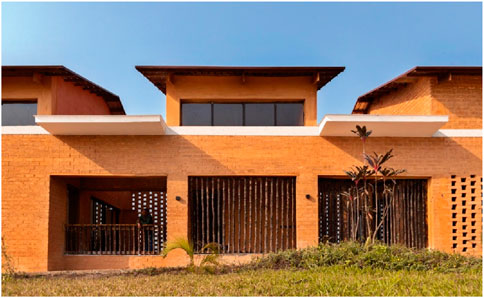
Figure 1. Ecology Green Farm “earth brick barn house” designed by MOE + Art Architecture for Yinka Shonibare Foundation, southwestern Nigeria (photo: Andrew Esiebo/Wallpaper).
On a broader African scale, the Great Mosque of Djenné in Mali is a prominent case of community-driven sustainability (Figure 2). Constructed entirely from sun-dried mud bricks and plastered with mud, the mosque is maintained annually through communal festivals where the entire city participates in replastering its walls. This practice sustains the structure physically and reinforces social cohesion, transmitting indigenous knowledge across generations. It exemplifies the intersection of architecture, culture, and sustainability, where community participation substitutes for energy-intensive modern maintenance practices (Morel and Charef, 2019).
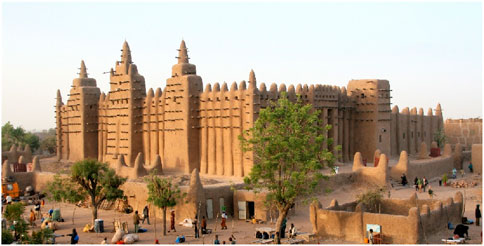
Figure 2. Community-maintained Great Mosque of Djenné, Mali — UNESCO World Heritage. Site Martha de Jong-Lantink, CC BY-NC-ND 2.0).
Similarly, the Ksar of Ait-Ben-Haddou in Morocco illustrates the longevity of rammed earth and adobe techniques (Figure 3). Recognised as a UNESCO World Heritage Site, it demonstrates the durability of mud construction in arid climates. It highlights how heritage preservation frameworks can integrate indigenous materials into global sustainability narratives (Toriola-Coker et al., 2021). Its endurance underlines that when adequately maintained, earthen structures can outlast many modern materials, challenging Nigerian professionals’ scepticism (Alzouby and Attia, 2022).
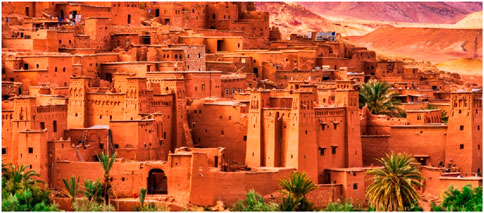
Figure 3. Ksar of Ait-Ben-Haddou, Morocco — resilience of rammed earth in desert conditions (photo: Claire, Restless Beans).
Source: Aït Ben Haddou. The Taos Pueblo in New Mexico, United States, provides another compelling example in the Americas (Figure 4). As one of the oldest continuously inhabited adobe settlements, Taos Pueblo demonstrates mud’s adaptability to cultural and climatic contexts. The settlement shows how indigenous construction techniques can meet contemporary living needs while preserving heritage. This case resonates strongly with arguments by Jegede et al. (2017) and Ibrahim et al. (2024), who call for integrating traditional materials and methods into modern architectural education in Nigeria.
The troglodyte dwellings of Matmata in Tunisia further showcase (Figure 5) how mud-based construction adapts to extreme climates. Built into the earth, these subterranean structures maintain stable interior temperatures, providing natural protection against desert heat. Their climate responsiveness exemplifies the concept of passive design, which aligns closely with contemporary sustainability principles emphasised in the Nigerian context (Onyejegbu et al., 2023; Onyia, 2023).
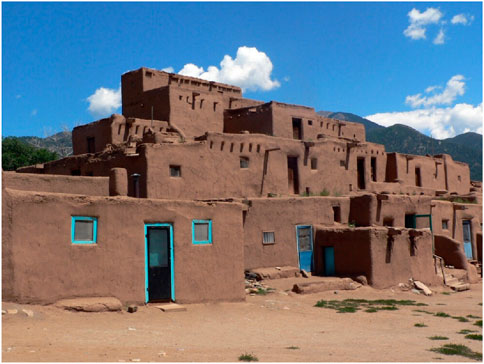
Figure 4. Taos Pueblo, New Mexico (photo: UNESCO World Heritage Centre). Source: UNESCO World Heritage Centre (1992), site no. 492 (Claire, 2024).
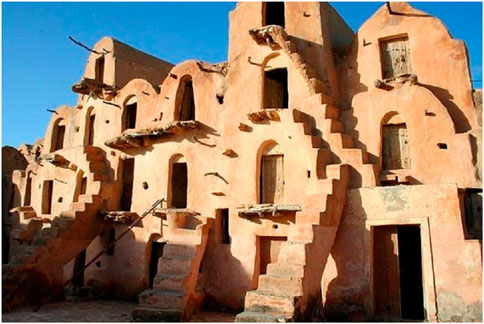
Figure 5. Matmata troglodyte dwellings, southern Tunisia (photo: Rethinking The Future, 2025).
These international examples illustrate that mud construction is not an inferior or outdated technology but a globally recognised sustainable practice with profound cultural and ecological relevance. Lessons from such case studies are applicable in Nigeria, where professional scepticism persists despite the demonstrated benefits of earthen materials (Vidak-Vasić et al., 2023). Global evidence shows that with proper policy support, technological innovation, and professional training, mud can play a pivotal role in creating future low-carbon, culturally resonant, and socially inclusive architecture.
2.6 Professional perceptions and barriers
Attitudes toward mud construction remain ambivalent. Vidak-Vasić et al. (2023) show deep-seated bias and misconceptions linger while awareness rises. In Nigeria, architects acknowledge mud’s potential (Onyia, 2023), but express concerns about quality control and building codes. Alzouby and Attia (2022) link societal preference for concrete with professional hesitation. However, newer techniques like compressed earth blocks and rammed earth are beginning to challenge these assumptions (Chadalavada and Sameer, 2020).
Recent surveys highlight that Nigerian professionals are cautiously optimistic, recognising environmental benefits but demanding clearer standards and institutional support before widespread adoption is possible (Onyia, 2023; Ibrahim et al., 2024).
2.7 Policy and institutional gaps
The lack of regulatory backing for traditional materials marginalises mud in official construction processes. Toriola-Coker et al. (2021) note that national codes rarely recognise indigenous materials, discouraging experimentation. Ibrahim et al. (2024) advocate for formal policy and training to mainstream mud construction. Dobjani and Papa (2022) also emphasise the importance of certifying local builders to preserve traditional knowledge and build professional confidence.
Government and investors are critical stakeholders in scaling mud construction. Government can provide subsidies, incentives, and recognition through codes, while investors offer financial support to reduce risks and demonstrate feasibility (Ibrahim et al., 2024; Alzouby and Attia, 2022).
Legislating mud construction through its inclusion in national building codes could transform it from a marginal practice into a recognised and credible building option, as seen in Morocco and New Mexico (Toriola-Coker et al., 2021; Dobjani and Papa, 2022).
Seeking external technical support through international research collaborations and technical exchange can help establish quality standards and certification systems, ensuring mud construction aligns with global benchmarks while preserving local identity (Morel and Charef, 2019; Vidak-Vasić et al., 2023).
2.8 Theoretical frameworks: Diffusion of Innovation and motivation
Rogers (2003) Diffusion of Innovation theory categorises adopters into five groups, innovators to laggards, based on their willingness to accept new practices. The uptake of mud construction in Nigeria follows this pattern, with most architects falling into early and late majority categories. Davis et al. (1992) and Igbaria et al. (1995) add nuance with the Motivation Model, which distinguishes intrinsic motivators like environmental ethics from extrinsic ones such as regulatory requirements. These frameworks provide a lens for understanding why professional adoption remains limited and how policy or educational changes could spur engagement.
In the Nigerian context, diffusion of mud techniques has been slowed by weak institutional support and professional scepticism. However, growing environmental pressures and cultural advocacy suggest that targeted incentives could accelerate adoption, shifting mud construction into the early majority phase (Onyia, 2023; Ibrahim et al., 2024).
3 Methodology
3.1 Research philosophy
This study adopts a pragmatic research philosophy, prioritising solutions to real-world problems by quantitative techniques. Pragmatism is well-suited for built environment research because it combines numerical data from professionals’ responses with contextual understanding of material usage (Keysar and Pearce, 2007). The objective is to understand both perceptions and practices regarding mud construction, so the pragmatic worldview enables a flexible and problem-oriented investigation.
3.2 Research approach
A quantitative approach was adopted, combining qualitative case study observations and quantitative survey techniques. The qualitative component focuses on real-life observations and architectural documentation of existing buildings designed with mud techniques. The quantitative dimension analyses perceptions, attitudes, and readiness levels among Nigerian architects on Lagos Island regarding adopting mud strategies in public buildings. This aligns with Dabare et al. (2023), who recommend integrating qualitative understanding with empirical professional feedback in construction studies.
3.3 Research design
The research design is descriptive and exploratory, examining existing professional engagement with mud construction and assessing readiness for broader integration. The descriptive design supports an objective assessment of how mud is currently used and perceived. At the same time, the exploratory element investigates gaps in policy, awareness, and professional capacity, which aligns with findings by Toriola-Coker et al. (2021) and Ibrahim et al. (2024).
3.4 Study population and sampling
The target populations are registered architects practising in Lagos Island, with experience in public and cultural building design. The choice of Lagos Island is strategic due to its architectural diversity and cultural significance. A purposive sampling technique was used to select respondents who directly engage with building materials and sustainable practices. This aligns with Alzouby and Attia (2022), who advocated stakeholder-specific data in traditional material studies.
3.5 Data collection instruments
3.5.1 Questionnaire survey
Structured questionnaires were distributed among professionals to obtain data on:
1. Awareness of mud techniques
2. Perceived benefits and limitations
3. Willingness to adopt in future designs
4. Perception of societal and institutional acceptance
This approach was inspired by Vidak-Vasić et al. (2023), who used professional questionnaires to quantify societal acceptance of traditional construction.
3.5.2 Case study reference (not primary)
Although this paper does not analyse case buildings directly, previous documented Nigerian examples (e.g., JK Randle Centre, Nike Gallery) were referenced where appropriate to validate or contrast professional responses (Onyejegbu et al., 2023).
3.6 Data analysis
3.6.1 Quantitative analysis
Data from the questionnaire were analysed using descriptive statistics, including frequencies and percentages, to reflect trends in awareness, perceptions, and challenges. These were interpreted thematically and compared with international benchmarks (Morel and Charef, 2019; Dabare et al., 2023).
3.6.2 Thematic analysis
Open-ended responses were categorised into themes such as:
1. Sustainability perception
2. Cultural relevance
3. Policy and education needs
4. Resistance and readiness indicators
This method helps uncover nuanced professional insights that structured questions might miss, aligning with qualitative techniques recommended by Dobjani and Papa (2022).
3.7 Ethical considerations
Participation was voluntary and anonymous. Respondents were informed of the research purpose, and data were handled confidentially, aligning with best practices in ethical architectural research.
4 Data presentation and analysis
4.1 Introduction
This section presents the data from the questionnaire distributed to architects practising on Lagos Island. The analysis is structured into thematic areas aligned with the study objectives: awareness, perceptions, readiness, barriers, and proposed incentives regarding mud construction. The data reveal prevailing attitudes and levels of engagement with indigenous materials, particularly mud, in public building projects. Thematic interpretation is supported by descriptive statistics and cross-referenced with scholarly perspectives from secondary data.
4.2 Awareness and knowledge of mud techniques
In Figure 6 the results show that a significant number of professionals are aware of mud construction techniques. Over 60% of respondents indicated they had encountered mud as a construction material in academic or professional settings. However, only a smaller portion (∼25%) had actively engaged with it in actual design projects.
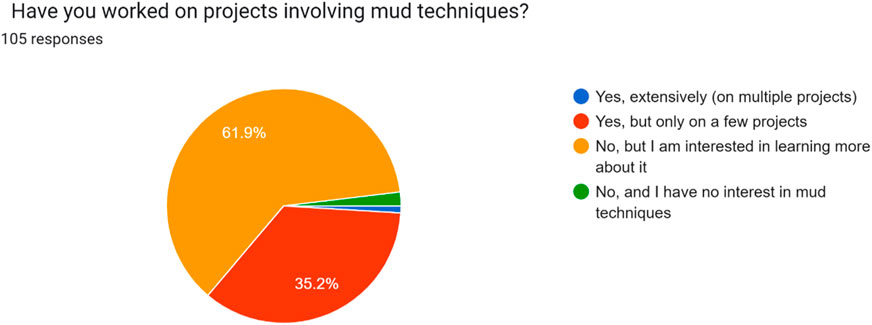
Figure 6. Responses to the question on prior professional experience with mud construction projects.
This corroborates Jegede et al. (2017), who noted the decline of traditional architecture training in Nigerian architectural education. The limited exposure to practical mud applications was also linked to poor documentation and knowledge transfer (Onyejegbu et al., 2023).
4.3 Perceptions of sustainability and cultural value
In Figure 7, over 70% of respondents agreed that mud is environmentally sustainable and climatically appropriate. Participants highlighted thermal comfort, low embodied energy, and renewability as core strengths, echoing empirical results from Cuitiño and Esteves (2018) and Giuffrida et al. (2021).
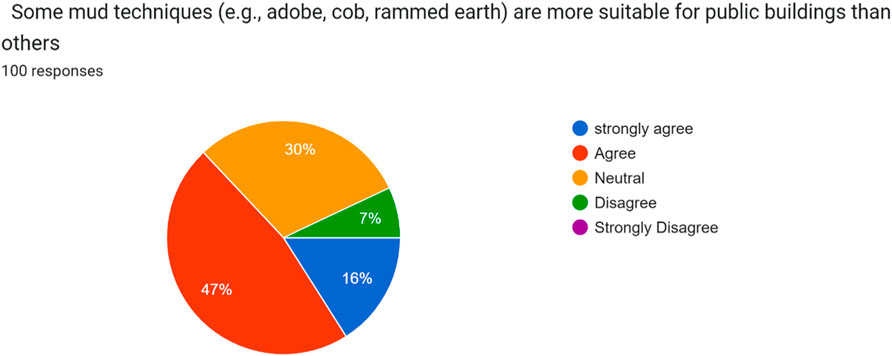
Figure 7. Responses on the suitability of mud techniques (adobe, cob, rammed earth) for public buildings.
Over 65% of respondents acknowledged cultural relevance, particularly for projects like cultural centres, museums, and art galleries. This supports Loew (2003) and Onyejegbu et al. (2023), who assert that mud architecture is a vehicle for preserving heritage amidst modernisation.
4.4 Willingness to adopt mud in contemporary projects
In Figure 8, only 28% of the respondents had recommended or used mud in recent projects, yet over 55% expressed interest in future adoption, particularly if improvements in durability and design flexibility were demonstrated. This shift aligns with Alam (2023), who advocates integrating modern techniques like rammed earth to enhance mud’s contemporary relevance.
Respondents also cited visual appeal, affordability, and local adaptability as incentives for future use, consistent with Dabare et al. (2023) and Tarrad (2020).
4.5 Key barriers identified
In Figure 9, a synthesis of structured and open-ended responses highlights the following constraints:
These align with the institutional challenges reported by Toriola-Coker et al. (2021) and the cultural bias against traditional methods noted by Alzouby and Attia (2022).
4.6 Suggested incentives and interventions
Participants proposed the following solutions:
1. Government incentives (e.g., grants, tax breaks) – 60%
2. Curriculum integration at the tertiary level – 54%
3. Professional workshops and CPD on mud construction – 51%
4. Pilot projects in urban areas – 47%
These insights validate the call by Ibrahim et al. (2024) and Onyia (2023) for systemic training and policy inclusion to normalise the use of traditional materials.
4.7 Interpretation of readiness and resistance levels
Respondents’ engagement levels were mapped using Rogers’ Diffusion of Innovations Theory (2003):
4.8 Summary of key findings
• Professionals on Lagos Island generally understand the value of mud construction, but regulatory, technical, and perceptual barriers constrain adoption.
• There is growing interest in integrating mud into public buildings, particularly for projects with cultural significance.
• Education, demonstration projects, and professional training are key to shifting readiness into action.
5 Discussion of findings
The data presented in Chapter Four reveals that while awareness of mud construction techniques is relatively high among Lagos Island-based professionals, practical adoption remains low. This validates the assertion by Onyejegbu et al. (2023) that traditional architectural knowledge in Nigeria is endangered due to systemic neglect and poor institutional support. Many respondents acknowledged mud’s environmental and cultural advantages, echoing the sustainability discourse in Morel and Charef (2019), who emphasised mud’s potential within a circular economy framework.
Despite this awareness, real-world adoption is hindered by technical concerns, regulatory disconnects, and negative perceptions. Toriola-Coker et al. (2021) similarly identified regulatory and policy gaps as barriers in the Nigerian context. Loew (2003) links this resistance to the broader clash between heritage preservation and modernisation, an issue further complicated by rapid urbanisation in cities like Lagos.
Interestingly, responses showed that many professionals are positioned within the “early majority” and “late majority” categories of Rogers’ Diffusion of Innovations theory (2003), indicating a crucial tipping point where targeted interventions could lead to widespread adoption. As Davis et al. (1992) suggested, a mix of intrinsic and extrinsic motivations, such as pride in heritage and government incentives, could influence uptake.
5.1 Policy implications
The evidence from this study affirms that Nigeria’s current regulatory frameworks do not favour indigenous building methods. Alzouby and Attia (2022) noted that modern construction codes often exclude traditional practices, discouraging professionals from experimenting with materials like mud. To counter this, revising national building standards is essential, formally recognising improved earth techniques like rammed earth, compressed earth blocks, and hybrid walling systems (Chadalavada and Sameer, 2020; Alam, 2023).
Policy inclusion should also prioritise training and technical certification, as emphasised by Dobjani and Papa (2022), who advocate for formal recognition of traditional knowledge systems. This aligns with Ibrahim et al. (2024), who call for broader government-backed frameworks to enhance local material utilisation.
Funding incentives, such as subsidies or tax breaks, for projects incorporating indigenous materials could also support early adopters and reduce financial risk. This would also address respondents’ concerns about the costs of improving mud’s durability and maintaining quality assurance (Morel and Charef, 2019).
5.2 Recommendation
Drawing on the questionnaire findings, policy gaps, and broader literature, the following recommendations are proposed to advance the professional adoption of mud construction in Nigeria:
5.2.1 Architectural education reform
Consistent with Jegede et al. (2017), the lack of formal exposure to indigenous materials in Nigeria’s architectural curriculum has left many young professionals unprepared for sustainable local practice. Architectural schools must integrate studio-based modules on mud construction, traditional climate-responsive design, and local resource management.
5.2.2 Pilot urban projects
Pilot schemes should be commissioned to test and demonstrate the feasibility of contemporary mud architecture in dense urban contexts. These could include public toilets, markets, community centres, and art galleries. Dabare et al. (2023) show how small-scale traditional material applications in Sri Lanka have reintroduced mud into mainstream discourse. A similar model could be replicated in Nigeria.
5.2.3 Professional capacity building
Seminars, workshops, and Continuing Professional Development (CPD) programmes should be introduced through professional bodies such as the Nigerian Institute of Architects (NIA). These should cover structural optimisation, fireproofing, and waterproofing of mud buildings (Giuffrida et al., 2021; Tarrad, 2020), dispelling myths of fragility and obsolescence.
5.2.4 Development of material standards
Collaboration between government bodies, universities, and industry stakeholders can lead to the development of Nigerian Standards for Earthen Construction. These must be built on international benchmarks but adapted to local climate, seismicity, and resource availability (Morel and Charef, 2019; Toriola-Coker et al., 2021).
5.2.5 Policy engagement and incentives
Survey results confirmed professionals’ demand for institutional backing. Regulatory bodies should formalise mud construction in Nigeria’s building codes (Ibrahim et al., 2024). Legislating mud techniques by including building codes and standards would provide legitimacy and encourage adoption (Dobjani and Papa, 2022). Financial incentives, such as subsidies or tax rebates for projects using indigenous materials, could promote broader adoption and reduce professional hesitation (Alzouby and Attia, 2022).
5.2.6 Role of government and investors
The role of government extends beyond regulation to include creating enabling policies, while private investors must support demonstration projects and innovative financing for sustainable mud construction (Ibrahim et al., 2024; Alzouby and Attia, 2022). Such collaboration would reduce the risks associated with innovation and encourage scaling.
5.2.7 Structural and technical innovation
To improve durability and performance, further research should explore hybrid walling systems, stabilisers (lime, cement, fibres), and waterproofing methods. Processing innovations such as compressed stabilised earth blocks and prefabrication would improve acceptability, usability, and sustainability (Chadalavada and Sameer, 2020; Giuffrida et al., 2021).
5.2.8 Broader geographic and demographic scope
Comparative studies should include professionals from other Nigerian regions, both urban and rural, to capture regional variations in knowledge, practice, and perception (Ibrahim et al., 2024; Onyia, 2023).
5.2.9 Longitudinal policy impact assessment
As sustainability-driven policies are introduced, their long-term impact on adoption patterns should be evaluated. This will reveal whether interventions such as tax incentives, curriculum reforms, or certification effectively shift practice (Toriola-Coker et al., 2021).
5.2.10 Digital tools and design modelling
Parametric tools and Building Information Modelling (BIM) should be integrated into mud-based design practice to improve precision, efficiency, and client communication (Dabare et al., 2023).
5.2.11 Urban prototypes and post-occupancy evaluation
Pilot urban prototypes (markets, galleries, public toilets), followed by post-occupancy evaluations, can provide empirical data on performance, cost, and user satisfaction. This evidence base strengthens advocacy for mainstreaming mud techniques (Alam, 2023; Morel and Charef, 2019).
5.2.12 External technical support
Collaboration with international experts, universities, and organisations can provide technical assistance and help standardise quality benchmarks for mud construction, aligning local practices with global best standards (Morel and Charef, 2019; Vidak-Vasić et al., 2023).
6 Conclusion
This study demonstrates that Nigeria stands at a critical juncture in its quest for sustainable and culturally grounded architecture. The overwhelming dependence on imported construction methods has created an ecologically unsustainable and culturally alien built environment. As a locally sourced, thermally efficient, and heritage-rich material, mud is a compelling alternative addressing environmental, social, and identity concerns.
While awareness is improving, readiness to adopt mud techniques in public buildings remains low due to technical, educational, and regulatory barriers. However, interest in adopting such methods exists, particularly among younger professionals open to innovation. As the findings indicate, meaningful reform in architecture education, building regulations, and government-led incentives can significantly improve adoption rates.
To build sustainable futures in indigenous architecture, Nigeria must embrace tradition not as a relic but as a foundation for innovation. Cultural revival, climate responsiveness, and material sovereignty must become pillars of contemporary design practice. A shift from marginalisation to mainstreaming will require coordinated action across academia, industry, and policy.
This study offers empirical insight into how traditional material knowledge can be leveraged to achieve Sustainable Development Goal 11 (Make cities and human settlements inclusive, safe, resilient and sustainable) by reinforcing local identity, reducing construction-related emissions, and promoting material sovereignty in architectural practice. Embracing mud not as a relic but as a resource could redefine architectural sustainability in Nigeria.
6.1 Future studies
While this study provides valuable insights into professional engagement with mud construction techniques in Lagos Island, it highlights several areas for further research. Future studies should:
1. Expand the geographic scope beyond Lagos Island to capture regional variations in perception and practice across Nigeria.
2. Undertake longitudinal studies to assess how evolving policies, incentives, and education reforms influence professional adoption of mud over time.
3. Explore hybrid technical innovations in mud stabilisation and prefabrication through experimental case projects.
4. Conduct post-occupancy evaluations of contemporary mud-based public buildings to generate empirical evidence on performance, durability, and user satisfaction.
5. Investigate client and government agency perspectives to complement professional viewpoints, offering a more holistic picture of adoption dynamics.
Such studies would strengthen the evidence base needed to reposition mud as a mainstream material for sustainable and culturally responsive architecture in Nigeria.
Data availability statement
The original contributions presented in the study are included in the article/Supplementary Material, further inquiries can be directed to the corresponding author.
Ethics statement
The studies involving humans were approved by covenant health research ethics committee (CHREC). The studies were conducted in accordance with the local legislation and institutional requirements. The participants provided their written informed consent to participate in this study.
Author contributions
OA: Writing – original draft, Writing – review and editing, Conceptualization, Data Curation, Methodology, Supervision, Validation, Project administration. EG: Writing – original draft, Writing – review and editing, Investigation, Formal Analysis, Data Curation, Methodology, Software, Resource, Validation.
Funding
The author(s) declare that no financial support was received for the research and/or publication of this article.
Acknowledgments
The authors express gratitude for the assistance extended by the Covenant University Centre for Research, Innovation, and Discovery (CUCRID) in facilitating the publication of this work.
Conflict of interest
The authors declare that the research was conducted in the absence of any commercial or financial relationships that could be construed as a potential conflict of interest.
Generative AI statement
The author(s) declare that Generative AI was used in the creation of this manuscript. The authors verify and take full responsibility for the use of generative AI in the preparation of this manuscript. Generative AI was used for language editing, summarising questionnaire results, improving clarity of scientific expression, restructuring content, and generating visuals (e.g., graphs and figures) based on author-provided data. All intellectual content, interpretations, and conclusions remain the responsibility of the authors.
Any alternative text (alt text) provided alongside figures in this article has been generated by Frontiers with the support of artificial intelligence and reasonable efforts have been made to ensure accuracy, including review by the authors wherever possible. If you identify any issues, please contact us.
Publisher’s note
All claims expressed in this article are solely those of the authors and do not necessarily represent those of their affiliated organizations, or those of the publisher, the editors and the reviewers. Any product that may be evaluated in this article, or claim that may be made by its manufacturer, is not guaranteed or endorsed by the publisher.
Supplementary material
The Supplementary Material for this article can be found online at: https://www.frontiersin.org/articles/10.3389/fbuil.2025.1674149/full#supplementary-material
References
Alam, F. (2023). Revival of gradually declined mud architecture practice in Northern Bangladesh. Unpublished seminar paper / thesis. Bangladesh University of Engineering and Technology. doi:10.13140/RG.2.2.14237.90082
Alzouby, A., and Attia, M. (2022). Public perceptions and the decline of traditional building methods in Middle Eastern cities. Int. J. Cult. Herit. Stud. 14 (2), 101–117. doi:10.18280/ijsdp.170114
Babalola, O. D., Ugah, U. K., and Ekeh, E. Y. (2024). Tropical building sustainability and the energy regulations. 2024081595. doi:10.20944/preprints202408.1595.v1
Chadalavada, K., and Sameer, S. (2020). Earthen architecture: sustainable and eco-efficient construction. Int. J. Sustain. Build. Technol. 3 (2), 20–27. doi:10.1201/b15685-12
Claire, C. (2024). Tips for visiting Aït ben Haddou – morocco’s picture-perfect village. Restless Beans. Available online at: https://therestlessbeans.com/visiting-ait-ben-haddou-morocco/.
Cuitiño, R., and Esteves, L. (2018). Long-term behaviour of adobe constructions under environmental conditions. J. Build. Phys. 42 (2), 163–181.
Dabare, T., Senalankadhikara, A., and Udawattha, C. (2023). Exploring traditional building materials for urban housing in Sri Lanka: benefits, obstacles, and a path forward amid economic challenges. Sustainability 15 (2), 986. doi:10.3390/su15020986
Davis, F. D., Bagozzi, R. P., and Warshaw, P. R. (1992). Extrinsic and intrinsic motivation to use computers in the workplace. J. Appl. Soc. Psychol. 22 (14), 1111–1132. doi:10.1111/j.1559-1816.1992.tb00945.x
Dobjani, E., and Papa, D. (2022). Adobe constructions in Albania: future application of earth as a conventional construction material. Civ. Eng. Archit. 10 (7), 3015–3027. doi:10.13189/cea.2022.100717
Ehkaese, I. U., and Amole, D. (2014). Urbanisation and the loss of traditional architecture in Benin City, Nigeria. J. Archit. Urbanism 38 (4), 263–272.
Giuffrida, G., Caponetto, R., Nocera, F., and Cuomo, M. (2021). Prototyping of a novel rammed Earth technology. Sustainability 13 (21), 11948. doi:10.3390/su132111948
Grigar, E. (2021). Inventing the new art world: on art institutions and their audience. Przegląd Socjol. Jakościowej 17 (3), 126–141. doi:10.18778/1733-8069.17.3.07
Ibrahim, R. A., Bala, S., Kolawole, R., Akinyemi, A. T., Taiwo, A. A., and Fakere, A. A. (2024). Significance of special concept on traditional architecture of the hausas in Nigeria. Br. J. Environ. Sci. 12 (1), 1–20. doi:10.37745/bjes.2013/vol12n1120
Igbaria, M., Guimaraes, T., and Davis, G. B. (1995). Testing the determinants of microcomputer usage via a structural equation model. J. Manag. Inf. Syst. 11 (4), 87–114. doi:10.1080/07421222.1995.11518061
Jegede, F., Adewale, B., Aderonmu, P., Ibem, E., Oluwatayo, D., and Fulani, O. (2017). “Designing to meet indigenous needs: place of traditional studies in architectural education. INTED2017 Proceedings. 2331–2336. doi:10.21125/INTED.2017.0672
Keysar, A. J., and Pearce, J. M.(2007). Decision making in sustainable development: using analytic hierarchy process to evaluate sustainable energy options. Environ. Dev. Sustain. 9(2), 135–150. doi:10.1007/s10668-005-9004-3
Morel, J. C., and Charef, R. (2019). What barriers affect the use of earth as a modern construction material in a circular economy? IOP Conf. Ser. Earth Environ. Sci. 225, 012053. doi:10.1088/1755-1315/225/1/012053
Ndukwe, I. (2022). Earth brick barn house is Yinka Shonibare’s hub of creativity in Nigeria. Wallpaper. Available online at: https://www.wallpaper.com/architecture/ecology-green-farm-moeaa-yinka-shonibare-foundation-nigeria.
Nichols, K. (2023). Indigenous dispossession and settler colonial art galleries: anguish at the National gallery of Victoria. Art. Hist. 46 (1), 102–123. doi:10.1111/1467-8365.12697
Odum, U. P., and Uwakonye, M. N. (2019). Architectural identity and urban development in Nigeria: the place of indigenous architecture. Niger. J. Environ. Sci. Technol. 3 (2), 91–104. Available online at: https://nijest.com/wp-content/uploads/2020/08/Vol-3-No.-2-Full-Issue.pdf.
Ogunbayo, B. F., Aigbavboa, O. C., Ogundipe, K. E., Akinradewo, O. I., Amusan, L. M., and Afolabi, A. O. (2021). Experimental assessment of properties of earth soil used in concrete production. IOP Conf. Ser. Mater. Sci. Eng. 1107 (1), 012177. doi:10.1088/1757-899X/1107/1/012177
Olofinnade, O., and Adeyinka, O. (2024). The utilization of pulverized waste tire rubber in a soil–cement composite for sustainable compressed earth brick production. Discov. Civ. Eng. 1 (69), 69. doi:10.1007/s44290-024-00075-x
Onyejegbu, M. N., Okonkwo, U. U., and David-Ojukwu, I. (2023). Traditional architectural mud huts in Africa: forms, aesthetics, history, and preservation in south-eastern Nigeria. Cogent Arts and Humanit. 10 (1), 2188781. doi:10.1080/23311983.2023.2188781
Onyia, M. (2023). Mud as a viable alternative to concrete in Nigerian residential housing: a survey of Benue state. J. Sustain. Built Environ. 9 (1), 47–59. Available online at: https://www.researchgate.net/publication/373707714_A_Review_of_Mud_Residential_Buildings_and_Sustainable_Development_in_Nigeria.
Rethinking The Future (2025). Lost in time: the Matmata Troglodyte Dwellings. Available online at: https://www.re-thinkingthefuture.com/city-and-architecture/a11830-lost-in-time-the-matmata-troglodyte-dwellings/.
Rogers, E. M. (2003). Diffusion of innovations (5th ed.). New York, NY: Free Press. Available online at: https://books.google.com/.
Tarrad, M. (2020). A vision to revive mud architecture, a community heritage architecture in Jordan, for low income. Int. J. Des. and Nat. Ecodynamics 15 (2), 269–275. doi:10.18280/ijdne.150218
Toriola-Coker, O., Adewole, A., and Aluko, O. (2021). Barriers to earth construction in Sub-Saharan Africa: regulatory, knowledge, and institutional challenges. J. Afr. Built. Environ. 6 (1), 31–45. doi:10.1088/1757-899x/1036/1/012023
UNESCO World Heritage Centre (1992). Taos Pueblo. UNESCO World. Available online at: https://whc.unesco.org/en/list/492/.
United Nations Environment Programme (2020). 2020 global status report for buildings and construction: towards a zero-emission, efficient and resilient buildings and construction sector. UNEP. Available online at: https://globalabc.org.
Keywords: mud architecture, sustainable design, indigenous construction, cultural heritage, Nigeria, professional perception, policy innovation
Citation: Adetoro OC and Gambo EB (2025) Sustainable futures in indigenous architecture: a study of contemporary professional engagement with mud techniques in Nigeria. Front. Built Environ. 11:1674149. doi: 10.3389/fbuil.2025.1674149
Received: 27 July 2025; Accepted: 16 September 2025;
Published: 14 October 2025.
Edited by:
Fernando Ávila, Universitat Politècnica de València, SpainReviewed by:
Vitta Ibrahim, Pyramids Higher Institute for Engineering and Technology, EgyptIkechukwu Ozigbo, University of Nigeria Enugu Nigeria, Nigeria
Copyright © 2025 Adetoro and Gambo. This is an open-access article distributed under the terms of the Creative Commons Attribution License (CC BY). The use, distribution or reproduction in other forums is permitted, provided the original author(s) and the copyright owner(s) are credited and that the original publication in this journal is cited, in accordance with accepted academic practice. No use, distribution or reproduction is permitted which does not comply with these terms.
*Correspondence: Emmanuel Bamidele Gambo, ZW1tYW51ZWwuZ2FtYm9wZ3NAc3R1LmN1LmVkdS5uZw==
 Olufunmilayo Comfort Adetoro
Olufunmilayo Comfort Adetoro Emmanuel Bamidele Gambo
Emmanuel Bamidele Gambo